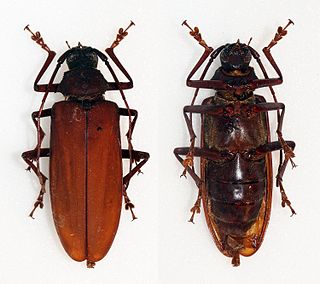
Prionus Geoffroy, 1762 is a genus of long-horned beetles of the subfamily Prioninae, tribe Prionini, widespread in Europe, Asia and North America.

Chelodina, collectively known as snake-necked turtles, is a large and diverse genus of long-necked chelid turtles with a complicated nomenclatural history. Although in the past, Macrochelodina and Macrodiremys have been considered separate genera and prior to that all the same, they are now considered subgenera of the Chelodina, further Macrochelodina and Macrodiremys are now known to apply to the same species, hence Chelydera is used for the northern snake-necked turtles.

The giant Fijian long-horned beetle is native to the island of Viti Levu in Fiji, and is one of the largest living insect species, with specimens around 15 cm long, excluding legs, antennae, or jaws. It is closely related to the Taveuni beetle, which is only marginally smaller. These beetles have powerful jaws, and should be handled with care when alive—when threatened, they produce a loud and fearsome hissing noise by squeezing air out from under their elytra. Various websites and other resources incorrectly indicate that this species is extinct; it is not, though the forest habitat on its home island is somewhat limited, so the beetle is potentially quite vulnerable.
The Taveuni beetle is known from the island of Taveuni in the Fiji, and is one of the largest living insect species, with specimens around 14 cm long, excluding legs, antennae, or mandibles.

Flower chafers are a group of scarab beetles, comprising the subfamily Cetoniinae. Many species are diurnal and visit flowers for pollen and nectar, or to browse on the petals. Some species also feed on fruit. The group is also called fruit and flower chafers, flower beetles and flower scarabs. There are around 4,000 species, many of them still undescribed.

Derobrachus is a genus of beetles in the Cerambycidae. It contains the following species:

Monochamus is a genus of longhorn beetles found throughout the world. They are commonly known as sawyer beetles or sawyers, as their larvae bore into dead or dying trees, especially conifers such as pines. They are the type genus of the Monochamini, a tribe in the huge long-horned beetle subfamily Lamiinae, but typically included in the Lamiini today.

Macrodontia is an American genus of long-horned beetles remarkable for their large size and for the large mandibles of the males in particular.

Cyphogastra is a genus of beetles in the family Buprestidae, containing the following species:

Lampetis is a genus of beetles in the family Buprestidae, containing the following species:

Psalidognathus is a genus of beetles belonging to the family Cerambycidae.

Strongylaspis is a genus of beetles in the longhorn beetle family, Cerambycidae.

Trachyderini is a tribe of long-horned beetles in the family Cerambycidae. There are at least 140 genera and 650 described species in Trachyderini.

Galerucella is a genus of leaf beetles in the family Chrysomelidae described by George Robert Crotch in 1873. It is widely distributed but absent in the Neotropics. Some species feed on waterlilies and are used as biocontrol of introduced, invasive waterlilies. Galerucella tenella feed on strawberry plants.

Dorysthenes is a genus of longhorn beetles of the subfamily Prioninae.

Coptops is a genus of longhorn beetles of the subfamily Lamiinae, containing the following species:

Aegosoma is a genus of long-horned beetles belonging to the family Cerambycidae.

Eumolpini is a tribe of leaf beetles in the subfamily Eumolpinae. It is the largest tribe in the subfamily, with approximately 170 genera found worldwide. Members of the tribe almost always have a longitudinal median groove on the pygidium, which possibly helps to keep the elytra locked at rest. They also generally have a subglabrous body, as well as appendiculate pretarsal claws.

Polyzonus is a genus of long-horned beetles. About 35 species have been described in this genus and they are distributed in the Indomalayan Realm.
Euporus is a genus of beetles belonging to the large subfamily Cerambycinae in the family of longhorn beetles (Cerambycidae).


















